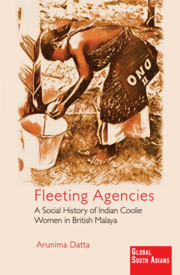Book contents
- Frontmatter
- Dedication
- Contents
- List of Tables
- List of Figures
- List of Abbreviations
- Acknowledgments
- Introduction
- 1 Coolie Women in the Empire’s Rubber Garden: Historical and Contextual Background
- 2 “Tapping” Resources: (Re)Figuring the Labor of Coolie Women on Estates
- 3 Managing “Partnerships”: Domesticity and Entrepreneurial Endeavors
- 4 Negotiating Intimacies and Moralities: Enticements, Desertions, Violence, and Gendered Trials
- 5 Becoming “Ranis”: Coolie Women as Rani Jhansi Regiment Recruits in World War II
- Conclusion
- Epilogue
- Glossary
- Notes
- Bibliography
- Index
Introduction
Published online by Cambridge University Press: 31 December 2020
- Frontmatter
- Dedication
- Contents
- List of Tables
- List of Figures
- List of Abbreviations
- Acknowledgments
- Introduction
- 1 Coolie Women in the Empire’s Rubber Garden: Historical and Contextual Background
- 2 “Tapping” Resources: (Re)Figuring the Labor of Coolie Women on Estates
- 3 Managing “Partnerships”: Domesticity and Entrepreneurial Endeavors
- 4 Negotiating Intimacies and Moralities: Enticements, Desertions, Violence, and Gendered Trials
- 5 Becoming “Ranis”: Coolie Women as Rani Jhansi Regiment Recruits in World War II
- Conclusion
- Epilogue
- Glossary
- Notes
- Bibliography
- Index
Summary
This book explores the lives of socially, politically, economically, and archivally marginalized Indian “coolie” women who migrated from British India, particularly south India, to British Malaya during the late nineteenth and early twentieth centuries to labor on Malaya's rubber plantations, especially in the Federated Malay States (FMS). The conventional historical narrative of South Asian labor migration under the British Empire emphasizes the experiences of coolie men and their instrumental role in the success of plantation colonies. This study, in contrast, traces coolie women's experiences and their crucial contributions to the plantation colony in British Malaya. Fleeting Agencies goes beyond the add-and-stir approach, however. It does not merely append the history of coolie women to existing labor migration histories. Rather, in exploring the gendered everyday experiences of coolie women in spaces of work and home and in their social, political, and intimate relations, the book exposes how gender was used in shaping colonial policies regarding migration, labor production, and reproduction, and also reveals the gendered spaces and strategies of nationalist movements. It explores the relationships and experiences of coolie women across plantation societies. In so doing, it also shows how coolie women capitalized on gendered understandings of labor, morality, and patriotism to carve out channels within which they could negotiate for their own interests.
As might be expected, plantation societies, colonial politics, and nationalist movements were all designed and conceptualized largely by men in positions of authority, and consequently often favored men's roles and voices over those of women, especially women laborers. Fleeting Agencies shows how colonial administrators, planters, managerial staff on estates, and Indian nationalists all deployed racialized and stereotyped images of South Asian coolie women in support of their own political agendas and the complex ways in which women responded to such stereotypes. As the chapters in this book show, women laborers actively engaged with, adapted, negotiated, rejected, and sometimes indirectly influenced stereotypes produced in these male-dominated spaces and institutions, and used them to form relations and find channels to make their voices heard in a world divided by political interests, to ensure their ability to make choices, and at times to ensure their daily survival. Fleeting Agencies is the first study to interrogate how coolie women in Malaya experienced and responded to colonial and nationalist efforts to categorize and control their identities.
- Type
- Chapter
- Information
- Fleeting AgenciesA Social History of Indian Coolie Women in British Malaya, pp. 1 - 26Publisher: Cambridge University PressPrint publication year: 2021

